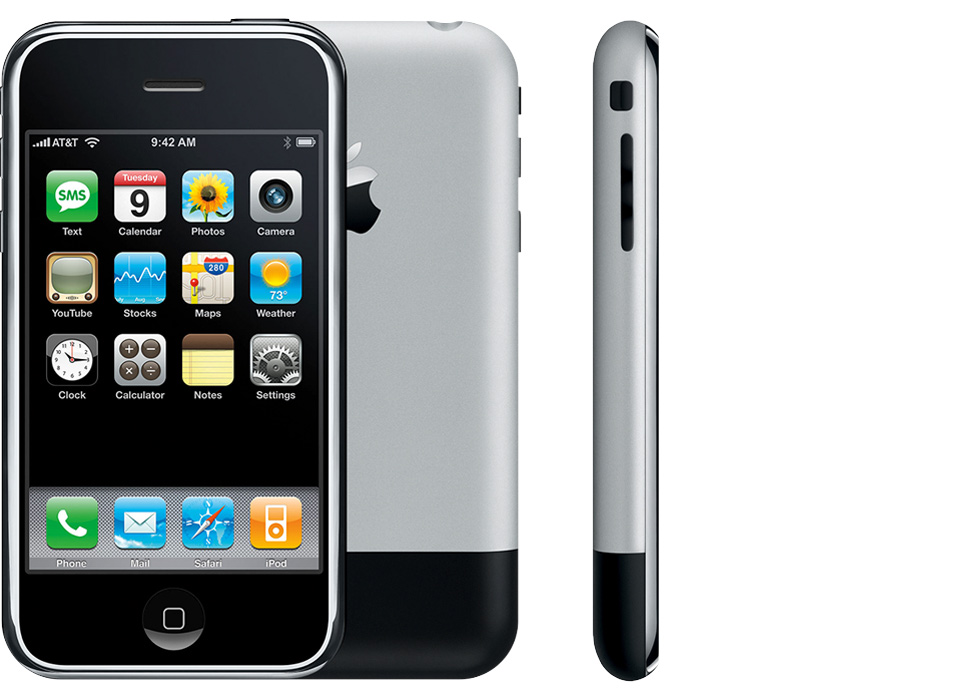Steve Jobs changed everything in January 2007 when he announced the iPhone. Like literally everything. Like I don’t think it’s unfair to say that he literally changed our evolution that first time he held up the iPhone.
Sure, smartphones existed before, but the was the first product that brought together the crucial mix of functionality, design, and hype to bring the smartphone to critical mass.
More than a phone
Remember back when we spoke to people on the phone? I don’t either, and spam callers have basically made the world look at phone calls as nuisances instead of a means of connection these days.
The iPhone was a phone but that functionality is almost an afterthought at this point. There are books that could be written about the impact the iPhone has made on the world but I want to talk about something more specific today: the iPhone is the best-selling camera in history.
A short history of digital cameras
Since the world began the concept of photography (literally meaning ‘drawing with light’) to capture portraits or landscapes, the process has worked the same: light enters through a lens and reflects onto a light-sensitive medium like film. Want to take more pictures? You need more film. Sports photographers used to go through thousands of rolls of film each year.
In 1999, Nikon announced the D1: the world’s first digital SLR camera (SLR stands for ‘single lens reflex’, basically meaning that there’s a mirror that covers the sensor and the reflex action pops it up as the camera shutter opens). It only had 2.3-megapixels of resolution and it cost an insane amount of money, right at $5000 (around $8770 in 2022 dollars). By today’s standards, it was terrible. But people lined up at camera stores throughout the country to purchase it.
The DSLR revolution kept growing as many manufacturers released new versions and developed new sensors with higher resolution. As they released these bigger cameras, so too came a market for smaller cameras with smaller sensors that had lower resolution, like the Olympus point-and-shoot I had with me for years or the venerable Canon S120.
Smartphones like the PalmPilot started coming out with rudimentary cameras on them, “potato-quality” as the youths would say. The market hierarchy was pretty well set:
- DSLR cameras for professional photographers and well-off hobbyists
- Point-and-shoot cameras for people on the go who didn’t want to carry around lenses
- Smartphone cameras for rudimentary, low-quality photos
…and then Steve Jobs announced the iPhone.
The iPhone changed photography forever
The iPhone came with a built-in camera, which wasn’t all that innovative by 2007. It was a low-megapixel camera too, coming in at 2 megapixels. So why did the iPhone change photography forever?
It wasn’t the best camera but it was the best smartphone camera. On the most popular phone in history. The one with the nice screen to look at photos on. And the one that came alongside the first unlimited cellphone data plans in the USA. Right at the time social media platforms like Facebook, Twitter, and MySpace were adding users by the hundreds of millions (and three years before Instagram debuted and turned photo-sharing up to 11).
It was a perfect storm. A capable portable camera in an era where EVERYONE wanted to see what everyone else was having for lunch amazing things.
How did the iPhone change the photography market?
Now, to be fair, the iPhone didn’t single-handedly change everything on its own. But where Apple went, competitors followed. Quickly, the point-and-shoot market lost steam, as people were hesitant to spend $300-400 on the newest point-and-shoot cameras when they could spend $600 on a phone which had a camera that was good enough.
All of a sudden, everyone was a photographer. As the iPhone and smartphone segment matured, we all began to see more incremental enhancements to things like the phone or the battery or the screen. Nowadays the part of each release that gets the most attention always seems to be: the camera.
“The best camera is the one you have with you.” I first heard this from Chase Jarvis and it’s true. Saying that to someone 15 years and 1 day ago would’ve sounded way different than it did the following day.
Today, the point-and-shoot market is effectively gone. Heck, the lower-end DSLR market is struggling and largely gone. Phone cameras have gotten infinitely better, most sporting multiple lenses and 12MP sensors (some cameras are even producing 48MP images!).
Each time you hit the shutter button on an iPhone, the camera module supposedly makes something like 1200 decisions before taking the photo. Portrait Mode is now ubiquitous on phone cameras when you used to need a DSLR for that blurry background “look”.
Today, I use Sony and Fuji mirrorless cameras that shoot at incredible resolution. I take those pictures and run them through a processing engine like Lightroom or Capture One, AirDrop the photo to my phone, and then post to social media. Or I could point my iPhone at the scene, “take” one picture, and watch Apple automagically and computationally make the best image right in front of me.
My Sony A7RIV versus iPhone 12 Pro Challenge
Astute readers will remember a trip I took to Zion National Park in November 2020. My buddy Mike and I climbed Angel’s Landing and had an absolute blast. I had just received the new iPhone 12 Pro but also had my Sony A7RIV with a $3000 lens on it. I took a variety of pictures with both cameras and put them into a challenge for my readers to see if they could identify which image was taken with which camera.
Camera Battle at Zion National Park: iPhone 12 Pro vs Sony a7rIV
The Results from my Zion Camera Battle: Should I Throw Away My Sony?
What amazed me wasn’t that people got some right and some wrong. Like I said in the results post, it was that opinions were fairly split, even among pro photographers I know and trust.
Is the iPhone really the most popular camera in history?
Let me hit you with some science. The image hosting website Flickr has been a photo repository for photographers and enthusiasts for decades.
Per Flickr, during the whole of history, there have been 31 iPhone variants. There are 157 million images uploaded to their platform from iPhone devices, with the iPhone 11, iPhone 12 Pro Max, and iPhone 12 Pro leading the way at 15, 12, and 10.6 million images, respectively.
Canon has been around for much longer than the iPhone. Not isolating for Canon cameras which existed before 2007, there are images from 307 Canon camera models on Flickr, 10x more than iPhone models. The total amount of images uploaded to Flickr from those 307 Canon cameras? 123 million. 34 million fewer than iPhone devices.
So, statistically, if you trust the science, yes the iPhone is the most popular camera in history. It was also the most revolutionary in a very specific sense. People loved taking pictures before the iPhone.
The iPhone’s killer app, though, was revolutionizing how people shared images.
Will smartphone cameras eventually take over professional cameras?
Honestly? I think so. Apple and Google currently have thousands of people working on camera technology, particularly in the area of Computational Photography, which is the ability to look at a scene and take the best parts of each of it to assemble a “perfect” image.
I own tens of thousands of dollars worth of professional camera gear. On the extreme end of the capability scale, I use a $12000 super telephoto lens for sports and action photography. The iPhone can’t do that. But can it do a lot of the portrait work I do? Honestly, it’s pretty close.
It’s not just photography, the iPhone changed our species
In only 15 years we’ve moved from a phone with a decent camera on it to a professional-quality still and video camera that also happens to have a phone on it. In another 15 years we may not even need the physical phone any longer, wearable/injected devices are not far away from everyday life.
Our memories have collectively gotten worse because we haven’t needed to remember as much since our phones remember everything for us. We have directions to get almost anywhere in the world sitting right in our pocket. All of our math teachers were proven wrong when they said we needed to know how to turn an equation into its polarized form because “you’re not going to have a computer in your pocket are you?”
How we interact with technology used to be two different entities (a human and a piece of technology) but we’re no doubt converging towards one another. I do not know what that means for the next 15 years of technology but there’s never been a better time to take a picture, that’s for sure.
Which model was your first iPhone? Tell me in the comments below!





Very nice piece. Having grown up in the darkroom world and having restricted myself to one 36 exposure roll per sports event I’m really torn about photography these days. I’m so very proud of the amazing shots I got with my Ricoh slr, especially sports’ fast action, but I’m equally pleased with shots I’ve taken with my Android phones. And to not be restricted to 36 exposures really helps!